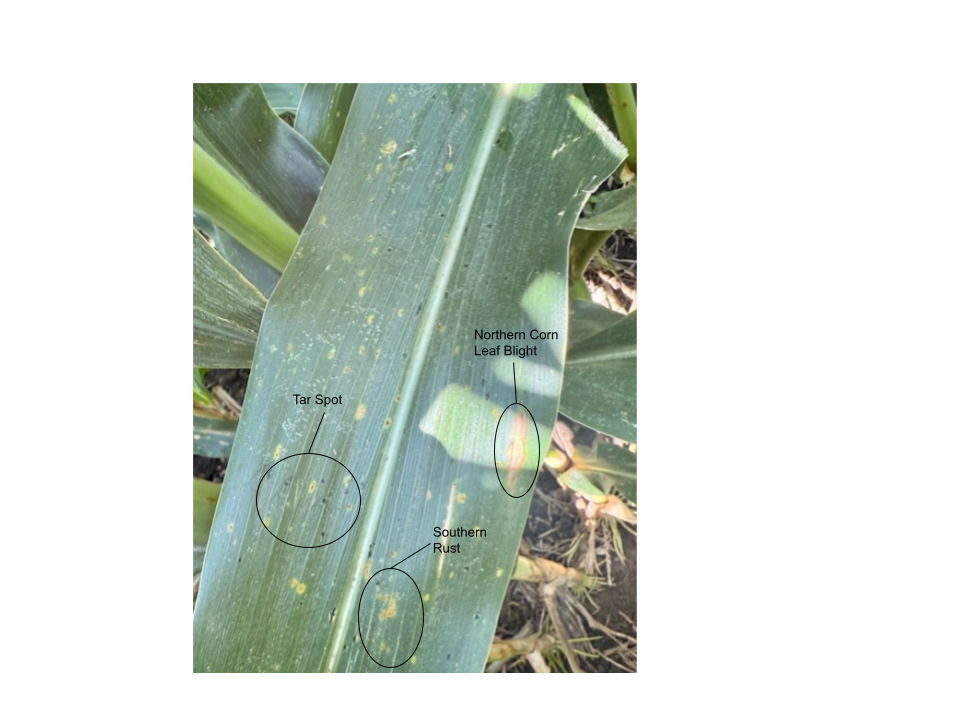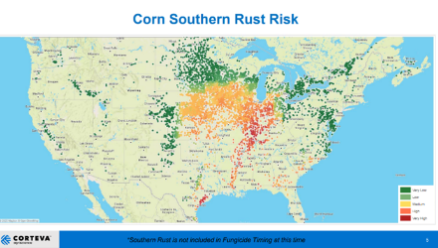Disease Moving in Upper Canopy
posted
by Makayla Bueltel on 8/18/2025
in
Weekly Newsletter
.png)
Within the next few weeks, we will begin to see crops moving toward maturity. Most of the corn is currently at the R5 (denting) growth stage, while soybeans are sitting around the R5 (beginning seed) stage, with some early-maturity varieties already reaching R6 (full seed). Over the past couple of weeks, we’ve also started to notice some yellowing in corn caused by nitrogen deficiencies due to the amount of rainfall we've received.
In soybeans, we are continuing to see Sudden Death Syndrome (SDS) show up in fields and spread. Over the last few weeks, some soybeans have started to lodge due to the combination of heavy rainfall, wind, and SDS pressure. So far, I haven’t seen any white mold settle in, but it will remain on my radar in the coming weeks. I’m out scouting every day, so if you’d like me to check on anything in your fields, please feel free to reach out to me, Makayla Bueltel, at (712) 210-3439.

This picture was taken in southern Audubon County. As you can see, we’re seeing a little bit of everything—Tar Spot, Southern Rust, and the early signs of Northern Corn Leaf Blight. This particular leaf came from the lower canopy, but these diseases are beginning to move into the upper canopy as well. We are starting to see disease develop just above the ear leaf, and in some cases, it has already reached the uppermost leaves near the tassel. Continued scouting will be important to monitor how quickly these infections progress.
Tar Spot Look-Out
As I have been out scouting corn fields here in Audubon County, Tar Spot has started to become more prevalent. Our primary disease focus this season has been on Southern Rust, which continues to be more severe than Tar Spot at this point. However, Tar Spot is something we need to keep on our radar as we scout. Currently, I am seeing around 1–4 lesions in the upper canopy, while the lower canopy is showing more consistent lesion development and higher incidence. From a management standpoint it is important to understand if the Tar Spot infections are home-grown or blown in. Home-grown Tar Spot originates from infected corn residue that carries the fungus over winter. These infections typically appear first in the lower canopy, and if a field had Tar Spot last year, early infections this season are more likely from that local source. Blown-in spores can travel long distances from storms and winds something we've experienced quite frequently this growing season. These infections often show up in the upper canopy as spores settle in from above. Although severity remains relatively low, continued warm and wet conditions will allow Tar Spot to progress further into the upper canopy.
.png)
Here is a map from Corteva showing the severity of Tar Spot across the United States. Currently, we are sitting in the medium-to-low risk category. However, if we look at the Southern Rust risk map, it highlights a much higher level of concern, not only here in the Midwest but also throughout the South. Southern Rust continues to flare up in corn and is now beginning to spread into the upper canopy. As, I have been out scouting southern Audubon County has been a hot spot for both Tar Spot and Southern Rust. However, we are seeing these infections across the entire local area with the level of severity varying depending on location, hybrid and fungicide application.

It is important to remember that the ear leaf and canopy are aiding in grain fill so these are the leaves that we need to protect when applying fungicide to reduce the risk of yield loss. Many are asking whether a second fungicide application is necessary as we move later into the growing season and seeing spots of Southern Rust moving up in the canopy. The Crop Protection Network has put together helpful information on Southern Rust management across different growth stages. Looking at their table, we can see that by the R4 stage that a second fungicide application would only be recommended in severe cases. While by R5 growth stage, we can see there is little to no benefit from applying a fungicide. It is important to consider the amount the disease in the upper canopy and growth stage when considering if a second fungicide application is needed. Southern Rust continues to be the main disease of concern this season, and scouting remains important as its progression depends heavily on fungicide timing, hybrid tolerance, and weather conditions.
To learn more about what Iowa State University experts and Agronomist are saying about Southern Rust refer to this week's Successful Farming article.
.png)
As we look ahead and make management decisions to help control the spread of Southern Rust in the future, there are a few key points to keep in mind. Southern Rust is unable to overwinter in Iowa because it requires a living host to survive, which gives us a fresh start each growing season. The level of infection we experience each year depends on spores being carried into Iowa by southerly winds from regions in Central America, where the pathogen can persist on living hosts throughout the winter. For more details on the current state of Southern Rust and what to expect in the future, refer to Alison Robertson, Extension Field Crops Pathologist, and Rebecca Vittetoe, Iowa State Extension Field Agronomist, in their recent crop update here.